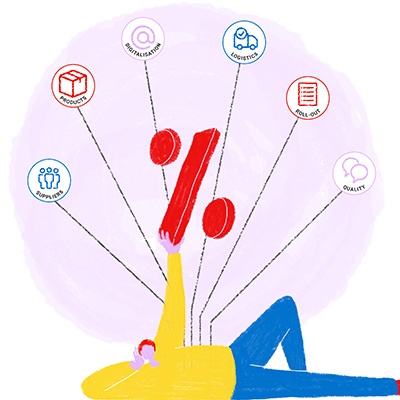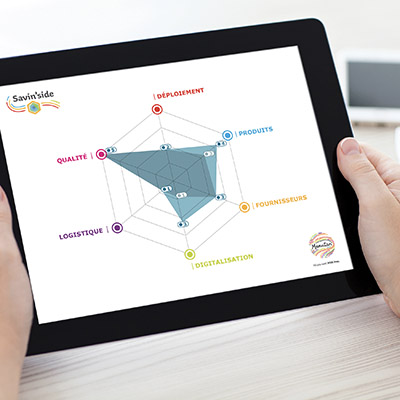Negotiations have a much more positive outcome when those involved reach a win-win agreement. Today, the expected gains for procurement departments are no longer simply financial. The prospect of acquiring goods or a service goes hand in hand with looking to have a positive impact on ecosystems. As a result, negotiations between buyers and their suppliers are becoming a driver for taking sustainable actions towards CSR (Corporate Social Responsibility) initiatives. This is called "positive negotiation".
In the business world, positive negotiation refers to a buying or selling operation conducted in line with ethical values. It is based on moral ideals among stakeholders and is motivated by a desire to sustain healthy, balanced and long-lasting relationships. With positive negotiation, partnerships are approached in such a way that the search for compromise does not result in action directed deliberately towards the other party, and at their expense. There are no ill intentions. Furthermore, buyers and suppliers can maintain their integrity throughout the negotiation, which is conducted with complete transparency.
Procurement tactics for effective negotiations with suppliers are evolving to ensure that companies incorporate a sense of responsibility into their approach. Read on to discover six positive negotiation tactics that buyers can use every day to achieve the perfect balance between pursuing economic performance and upholding ethical values:
A focus on the human touch
As in any profession based on human relationships, buyers' performance can involve efforts to align themselves with their contacts. By being open and empathetic, buyers can let their personality shine through, better understand their contacts' needs and adjust the methods they use to reach a compromise. While this approach is already widely employed in the business world, it is becoming a "positive negotiation" tactic in procurement, where being in tune with suppliers involves trying to uncover quality relationships based on trust and transparency.
Making compromises together
Positive negotiation can take the form of a collective approach to making procurement-related compromises. Furthermore, because it is based on the advantages of conversation, this tactic is consistent with creating healthy and long-lasting relationships built on solid foundations. In other words, a "blank page" is needed when starting to look for a compromise. With this approach, the ins and outs of the negotiation are addressed in full, one after the other. This ensures that there are no "hidden weaknesses".
The role of mediator
Procurement departments may choose to take on the role of mediator during positive negotiations. Buyers are then able to ensure that goods or services are acquired through an objective analysis of the advantages offered by each stakeholder. Regardless of the features of the supplier's goods or services and irrespective of the buyer's needs, the negotiation is primarily motivated by the desire to preserve the interests of each party. Maintaining a good understanding and healthy, long-lasting relationships gives this negotiation tactic its positive dimension.
The technician's deterrent
The technician's tactic in positive negotiation draws its strength from an expert's almost-infallible nature. It's a type of soft deterrent tactic. By showing that they have a deep understanding of negotiations in general and how they work, buyers discourage the other party from bluffing or using tricks. All they need to do is adopt a relevant and discerning critical stance. This approach will still demonstrate ethical values as long as buyers' tactics remain "inoffensive". Buyers thus protect their interests by blocking off all the entry points that would give them a less advantageous position in the negotiation.
An iron fist in a velvet glove
Positive negotiation also relies on more forceful tactics. However, this approach is still compatible with moral ideals, as being firm does not necessarily equate to an aggressive relationship. As soon as the negotiation begins, buyers can outline how far they are prepared to go in order to clearly establish the amount of room for manoeuvre. As a result, transparency and honesty take precedence, and conversations are held with mutual respect. This negotiation tactic is still positive because it neither overpowers suppliers nor makes them feel uncomfortable. It is not a matter of cutting them off, but of transparently addressing the terms of a good business agreement.
Drawing the other party in like a storyteller
Procurement departments can also take inspiration from the skills shown by speakers, rhetoricians or storytellers. This positive negotiation tactic is shaped by buyers' ability to get their suppliers on board with "predictions" about their activities. Going beyond throwing well-thought-out arguments and counterarguments back and forth in order to reach a compromise, this negotiation tactic relies on the power of the imagination. When this story is based on ethical values, the positive aspect is achieved. In this way, storytelling draws listeners into the idea of protecting society and the environment, while writing buyers and suppliers into the same narrative.
When it comes to addressing social and environmental concerns specific to CSR, negotiation in procurement is no exception. Companies can use it as a driver in order to achieve a sustainable impact. In this sense, negotiation is therefore positive. Buyers are still able to use a variety of negotiation tactics, but they all remain driven by the pursuit of healthy, balanced and honest relationships.








